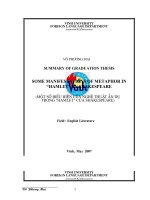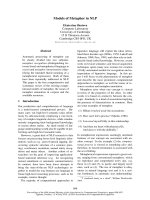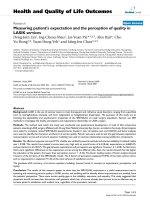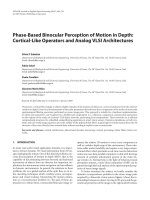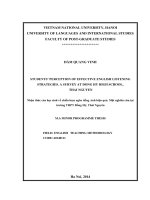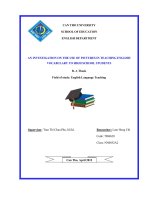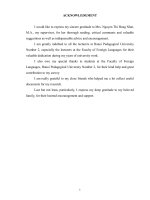- Trang chủ >>
- Cao đẳng - Đại học >>
- Luật
STUDENTS’ PERCEPTION OF BENEFITS OF METAPHOR IN LEGAL ENGLISH
Bạn đang xem bản rút gọn của tài liệu. Xem và tải ngay bản đầy đủ của tài liệu tại đây (881.78 KB, 72 trang )
MINISTRY OF EDUCATION AND TRAINING
HO CHI MINH CITY UNIVERSITY OF LAW
GRADUATION THESIS
B.A. DEGREE IN ENGLISH
Major: Legal English
STUDENTS’ PERCEPTION OF BENEFITS OF
METAPHOR IN LEGAL ENGLISH
Supervisor : M.A. NHAM THANH LAP
Student
: BUI KHANH LINH
Student ID : 1652202010031
Class
: LE41
Ho Chi Minh City, 2020
MINISTRY OF EDUCATION AND TRAINING
HO CHI MINH CITY UNIVERSITY OF LAW
GRADUATION THESIS
B.A. DEGREE IN ENGLISH
Major: Legal English
STUDENTS’ PERCEPTION OF BENEFITS OF
METAPHOR IN LEGAL ENGLISH
Supervisor : M.A. NHAM THANH LAP
Student
: BUI KHANH LINH
Student ID : 1652202010031
Class
: LE41
Ho Chi Minh City, 2020
ACKNOWLEDGEMENTS
I would like to take this opportunity to express my deep gratitude to those
persons who provided me with valuable advice and enthusiastic supports during the time
I worked on this thesis.
I would like to express my genuine appreciation and grateful thanks to my
supervisor, Mr. Nham Thanh Lap, who gave me practical guidance, comforting words,
and did take a chance on me, introducing me to this research area. Under his supervision,
I become more independent, raised my sense of initiative, and developed my thinking
to a certain extent in the research project. To my way of thinking, fortune smiled on me
when I was supervised by Mr. Lap, embracing his words of wisdom with a wealth of
experience.
I would like to express my sincere thanks towards all legal English and highquality law majored students who enthusiastically participated in my study for their
valuable feedback and comments. Their true reflection on the past experience was
valuable data for my study. To those who took part in the interview, I owe them a great
debt of gratitude.
I owe special thanks to AnhEm for their generous support throughout this study.
I owe my dearest friend - Nau, a favor for what she has been doing. Her words
of encouragement really worked on me.
Above all, I would like to thank the support and love of my family and friends
and their constant source of inspiration.
i
TABLE OF CONTENTS
ACKNOWLEDGEMENTS...........................................................................................i
TABLE OF CONTENTS............................................................................................. ii
LISTS OF ABBREVIATIONS .................................................................................... v
LISTS OF TABLES AND FIGURES.........................................................................vi
TÓM LƯỢC ............................................................................................................... vii
ABSTRACT ............................................................................................................... viii
CHAPTER 1 INTRODUCTION ................................................................................. 1
1.1
Rationale for the research study ....................................................................... 1
1.2
Research aims ................................................................................................... 2
1.3
Significance of the study .................................................................................. 2
1.4
Organization of the thesis ................................................................................. 2
CHAPTER 2 LITERATURE REVIEW ..................................................................... 3
2.1
Metaphor .......................................................................................................... 3
2.1.1 Definition .................................................................................................. 3
2.1.2 Classification ............................................................................................ 4
2.2
Metaphor in legal English and classification ................................................... 7
2.2.1 Structural metaphors in legal English ....................................................... 9
2.2.2 Orientational metaphors in legal English ................................................ 10
2.2.3 Ontological metaphors in legal English .................................................. 11
2.3
Benefits of metaphor in legal English ............................................................ 13
2.3.1 Reactions ................................................................................................. 13
2.3.2 Understanding ......................................................................................... 14
2.3.3 Transformation and motivation .............................................................. 16
2.3.4 Applications ............................................................................................ 17
2.4
Relevant studies.............................................................................................. 19
2.4.1 Studies on metaphor in legal English ..................................................... 19
ii
2.4.2 Significance of the present study ............................................................ 22
CHAPTER 3 RESEARCH METHODOLOGY ....................................................... 24
3.1
Research questions ......................................................................................... 24
3.2
Research design .............................................................................................. 24
3.3
Participants ..................................................................................................... 24
3.3.1 Sampling ................................................................................................. 24
3.3.2 Legal English majored students .............................................................. 25
3.3.3 High-quality law majored students ......................................................... 26
3.4
Research instruments...................................................................................... 26
3.4.1 Quiz ......................................................................................................... 26
3.4.2 Questionnaire .......................................................................................... 26
3.4.3 Interviews................................................................................................ 27
3.5
Data collection................................................................................................ 27
3.5.1 Administering the questionnaire ............................................................. 27
3.5.2 Administering the interviews .................................................................. 27
3.6
Statistical method ........................................................................................... 28
3.7
Research procedure ........................................................................................ 28
CHAPTER 4 FINDINGS AND DISCUSSION ........................................................ 29
4.1
Findings .......................................................................................................... 29
4.1.1 Quiz results ............................................................................................. 29
4.1.2 Questionnaire results............................................................................... 29
4.1.3 Questionnaire analysis ............................................................................ 30
4.2
Discussions ..................................................................................................... 33
4.2.1 Perceptions on benefits of metaphor in legal English ............................. 33
CHAPTER 5 CONCLUSION .................................................................................... 38
5.1
Summary ........................................................................................................ 38
5.2
Possible implications ...................................................................................... 38
iii
For legal English major ............................................................................................ 38
For law major............................................................................................................ 39
For lecturers .............................................................................................................. 39
5.3
Limitations of the study and recommendations for future research ....... 40
Limitations ................................................................................................................ 40
Recommendations..................................................................................................... 40
REFERENCES ............................................................................................................ 42
APPENDICES ............................................................................................................. 51
APPENDIX 1: QUESTIONNAIRE ........................................................................... 51
Questionnaire in English ...................................................................................... 51
Questionnaire in Vietnamese ............................................................................... 55
APPENDIX 2: INTERVIEW QUESTIONS............................................................ 59
Interview questions for student participants in English ....................................... 59
Interview questions for student participants in Vietnamese................................. 60
APPENDIX 3: QUANTITATIVE DATA ANALYSIS ........................................... 61
iv
LISTS OF ABBREVIATIONS
LE
Legal English
HQL
High-quality law major
v
LISTS OF TABLES AND FIGURES
List of Tables
Table 3.1: The participants............................................................................................ 25
Table 4.1: Participation of quiz takers .......................................................................... 29
Table 4.2: Selection of questionnaire participants ........................................................ 30
Table 4.3: Level of agreement towards benefits of metaphor in legal English ............ 30
Table 4.4: Level of agreement towards variables ......................................................... 31
Table 4.5: Mean score of each item in cluster Reaction ............................................... 31
Table 4.6: Mean score of each item in cluster Understanding ...................................... 32
Table 4.7: Mean score of each item in cluster Transformation .................................... 32
Table 4.8: Mean score of each item in cluster Application .......................................... 32
Table 4.9: Level of agreement towards benefits of metaphor in legal English between
two groups: high-quality law majored students and legal English students ................. 32
List of Figures
Figure 3.1: Research procedure .................................................................................... 28
Figure 4.1: Level of students’ agreement among four clusters ..................................... 31
vi
TÓM LƯỢC
Nghiên cứu này là sự phản ánh nhận thức của sinh viên về lợi ích của ẩn dụ trong tiếng
Anh pháp lý. Nghiên cứu khảo sát ý kiến của sinh viên, dữ liệu cả định tính và định
lượng được thu thập. Dữ liệu định lượng được thu thập từ bảng câu hỏi phát cho 36 sinh
viên của ba khoá liên tiếp đang học chương trình cử nhân Ngơn ngữ Anh – chuyên ngành
tiếng Anh pháp lý và chương trình cử nhân chất lượng cao Luật. Dữ liệu định tính được
dùng để thu thập và phân tích ý kiến sinh viên. Nhận thức của sinh viên được phân tích
định lượng và định tính thơng qua bốn yếu tố là phản ứng, hiểu biết, chuyển đổi nhận
thức và ứng dụng. Tuy nhiên, mỗi sinh viên nhận thức các yếu tố này ở các mức độ khác
nhau. Kết quả nghiên cứu cho thấy nhận thức tích cực của sinh viên chủ yếu vào hai yếu
tố: phản ứng và chuyển đổi nhận thức. Hầu hết sinh viên tham gia đều nhận thức được
ẩn dụ trở nên quan trọng hơn đối với tiếng Anh pháp lý. Mặc dù một vài sinh viên Luật
năm cuối cho rằng ẩn dụ trong tiếng Anh pháp lý còn tương đối mơ hồ. Rõ ràng, mức
độ đồng ý thấp hơn đối với yếu tố hiểu biết và ứng dụng cũng được chú ý trong nghiên
cứu này.
vii
ABSTRACT
This case study reflects students’ perception of the benefits of metaphor in legal English.
In this quantitative and qualitative research study, data were firstly gathered through a
questionnaire completed by 36 undergraduate students from three consecutive cohorts
of two majors: law and legal English. Students’ perceptions disclosed from the
quantitative and qualitative analyses are associated with reaction, understanding,
transformation, and application. However, each student perceives these elements in a
varying extent. A qualitative approach is used to collect and analyze student opinion.
The results show positive outcomes mostly in students’ reaction and transformation.
Most participants are aware that metaphor turns more significant in legal English. Apart
from positive responses of the majority, a number of senior law students claim that
metaphor leaves them confusion in legal English. Evidently, their lower levels of
agreement towards understanding and application are also noticed in this paper.
KEY WORDS: students’ perception, metaphor, legal English
viii
CHAPTER 1
INTRODUCTION
The current chapter contains four sections. Starting off with the rationale, the
chapter presents the research aims, succeeded by the significance of the research and
the organization of the thesis in the last section.
1.1 Rationale for the research study
The field of language and the law is inherently interdisciplinary, a close
connection between law and language, both of which surround us in modern-day
society1 (Filipović, 2013). In particular, the emergence of legal language deals with
fixed terms having specific meanings, specialized text structures, formal language, and
notably distinct lexicon2 (Mellinkoff, 1963). Also, many assume that the nature of the
language of the law must be exclusively concrete and plain, leaving no place for
rhetorical expressions. However, there is range of applications of rhetorical device –
metaphor which is quite prevalent and diversified as an important methodological tool
in legal language. A glance at intensive studies in this field can reveal how common
metaphor exists in legal English.
As regards the curriculum of law-majored students and English-majored
students in Ho Chi Minh City University of Law, students need to acquire legal language
in mother tongue and English as well. To be more specific, their programs mainly offer
subjects in English Language and Legal Linguistics namely Legal Reasoning and
Methodology, Contract Law, Corporation Law, Comparative Law, Law of the Sea,
WTO Law, Tort Law, US and EU Competition Law, Legal Translation and
Interpretation, International Trade Terminology, to mention just a few. Undoubtedly,
legal English is considered as one of the most crucial parts of the programs as well as
the most presumably necessary skill for all students to consider acquiring.
Based on the context in the present study, students need to develop a heightened
respect for linguistic precision and legal content also. It is apparent that legal English
1
Filipović, L. (2013). The Role of Language in Legal Contexts: A Forensic Cross-Linguistic Viewpoint. In Law
and Language: Current Legal Issues Volume 15. Oxford University Press (Vol. 15, pp. 328). Retrieved May 17,
2020, from />2
Mellinkoff, D. (1963). The Language of the Law. Boston & Toronto: Little, Brown and Company.
1
abovementioned is so complicated and hard-to-understand. For learners specifically,
learning legal English is supposed to be challenging with merely terms which are
conventionally theoretical and formuliac (Haigh, 2009; Eades, 2010; Richard, 2014;
Bradae, 2013; Hyatt, n.d.). Acknowledging this hindrance, my present work will
explicitly introduce metaphorical expressions in legal English and measure students’
perception of benefits of metaphors in respect of legal English.
1.2 Research aims
The objective of this research is to determine the high-quality law and legal
English majored students’ perception of benefits of metaphor in legal English.
1.3 Significance of the study
A closer look to the literature, however, reveals that a scarcity of studies on
students’ perception of benefits of metaphor in legal English. In broader scenario, the
current study aims to fill this gap, investigating how beneficial metaphor is in legal
English from the perspective of learners.
1.4 Organization of the thesis
The thesis consists of four chapter: (1) Introduction, (2) Literature review, (3)
Methodology, (4) Findings and discussions, (5) Conclusion.
Chapter 1 presents the rationale, the aims, the significance of the study, and the
organization of the whole thesis.
Chapter 2 reviews the relevant literature together with related studies, providing
background knowledge and constructing the theoretical framework for the study into
students’ perception of the benefits of metaphor in legal English. Information on the
previous studies related to students’ perception of metaphor’s benefits suggested in
literature is presented for later comparison with research findings.
Chapter 3 describes the research methodology in detail, comprising research
questions, research design, research participants, research instruments, data collection
and statistical method.
Chapter 4 presents quantitative and qualitative data analyses, addressing the
research questions and provides major findings and discussions on the findings.
Chapter 5 provides a summary of findings. Implications, limitations of the
study, and recommendations for further studies are revealed.
2
CHAPTER 2
LITERATURE REVIEW
This present chapter provides a critical review of literature relevant to students’
perception of metaphor in legal English. The chapter focuses extensively but not
exclusively on (1) introduction to metaphor, (2) introduction to metaphor in legal
English, (3) benefits of metaphor in learning legal English, and (4) related studies.
2.1 Metaphor
2.1.1 Definition
Metaphor derives from the Greek word “metapherein”, in which “meta” means
“over” and “pherein” means “to bear” or “to carry”, and for this reason, metaphor means
the carrying of meaning of one word to another word (Gentzler, 2000; Taverniers, 2002).
Back to Aristotle’s treatises on Rhetoric and Poetics, metaphor was considered as a
rhetorical device used as an ornament in literary works. For a long time, metaphor was
known as a figure of speech, as mentioned in the most definitions of metaphor.
In recent decades, the idea of metaphor has got certain well-known recognition
among largely diverse schools of thought (Lakoff & Johnson, 1980; Newmark, 1988;
Black, 1993; Hurford, Heasley, & Smith, 2007). Noticeably, the paradigm of metaphor
study was the publication of Metaphors We Live By claiming that “our ordinary
conceptual system, in terms of which we both think and act, is fundamentally
metaphorical in nature”3 (Lakoff & Johnson, 1980, p. 3). By this way, metaphors are
fundamental to the structuring of our thought and language, and is an ordinary activity
of thinking. The cognitive theory of metaphor is served as a major breakthrough in the
study of metaphor and perhaps one of the most influential works in turn-of-the-century
linguistics. Indeed, metaphors are conceptual operations reflected in human language
that enable speakers to structure and construe abstract areas of knowledge and
experience in more concrete experiential terms. As the influence of metaphor is in every
part of our everyday language pervasively, it is not only a matter of language, but also
a matter of thought and action (Lakoff & Johnson, 1980; Gibbs, 1994; Kövecses, 2010).
3
Lakoff, G., & Johnson, M. (1980). Metaphors We Live By. Chicago and London: The University of Chicago
Press, p. 4.
3
To illustrate how conceptual metaphor works, metaphor is a mapping of
structure from a familiar area of knowledge, called the source domain, to conceptualise
an area of knowledge that is less familiar, the target or recipient domain. The source of
donor domain is kind of a concrete concept which is typically grasped through our
ordinary experience within a vast background of the physical world around us. The
interaction between these two domains is established by anaglogical mappings, in
which the relationship is described as “a set of systematic correspondences … [which]
are often referred to as mappings”4 in order to structure the target domain in a more
accessible way to human understanding (Kövecses, 2010, p. 7). Evidently, in this
framework, metaphor is no longer considered merely as an ornamental device that is
restricted to literature and poetry. Though most figurative language in form of frozen
expressions have become conventional (Hurford et al., 2007), their metaphorical nature
is hardly ever recognized. In other words, a general understanding of metaphor is an
“automatic” interpretation made by us (Glucksberg, 2008).
2.1.2 Classification
Having attemped to define what metaphor is, a question of the possibility of
classification of metaphor may arise. It seems to be various ways of classifyting
metaphors. With reference to that, the attention will be focused on the classification
pointed out by Kövecses (2010) in his book Metaphor: A Practical Introduction which
includes classifcation according to: the conventionality of metaphor, the nature of
metaphor, the level of generality of metaphor, and the cognitive function of metaphor.
However, it is well-documented that the way of classification based on the cognitive
function is much more prevailing (Kövecses, 2010; Li, 2010; Boers, 2011; Jumanca,
2012; Soloshenko, 2016). There are ample evidence in English of numerous structural
metaphors, orientational metaphors, and ontological metaphors which are highly
structural and rule-governed.
Cognitive function of metaphor is all about how ordinary people are thinking
about or seeing the world (Lakoff & Johnson, 1980; Kövecses, 2010). For a clearer
exposition, division of conceptual metaphors can be shown according to the cognitive
4
Kovecses, Z. (2010). Metaphor. A practical Introduction, Second Edition. New York: Oxford University Press,
p. 38.
4
functions. On this foundation, Lakoff and Johnson (1980) distinguish three different
types of conceptual metaphors, in order of specificity: structural, ontological, and
orientational.
Structural metaphors are abstract metaphorical systems in which the source
domain provides a relatively great deal of knowledge structure for the target concept. In
other words, multiple individual linguistic expressions are to enable speakers to evoke
target A by means of conceptual mappings between target A and the structure of source
B. Consider such expressions as follows: (1) Her point of view is indefensible. (2) They
attacked everything we said. (3) I finally won/lost the argument. (4) We demolished their
argument. (5) My strategy against their argument was weak. (6) Our criticism of his
claim was right on target.5 It suggests that such actions provide evidence that argument
is structured, understood, performed and talked about in the concept of war (Ibid, p. 4).
In this case, without a physical attack, obviously we have a war of words through the
words of war that we utilize. Through these examples, Lakoff and Johnson explained
that an abstract conceptual domain “argument” is understood through a specific
conceptual domain of “war”. Therefore, it not only explains why the particular
expressions mean what they do but provide a basic overall structure as well. “Without
the metaphor it would be difficult to imagine what our concept of argument would be”6
(Kövecses, 2010).
Orientational metaphors are the experience of basic spatial orientation such
as up – down, inside – outside, deep – shallow, front – back, and the like by associating
an abstract knowledge area with some aspect of experiential grounds. English
expressions such as the following seem to relate to the abstract subject of happiness with
being physically located UP position: (1) I’m feeling up today, (2) That movie boosted
my spirits, (3) Her spirits rose at the news. These examples generally follow the same
principles: HAPPY IS UP derived from the body posture. Normally, when they are
happy, they raise up their head and straight up their back and when people are sad or
depressed, they often droop, as can be seen from the conceptual metaphor SAD IS
5
Lakoff, G., & Johnson, M. (1980). Metaphors We Live By. Chicago and London, The University of Chicago
Press, p. 4.
6
Kovecses, Z. (2010). Metaphor. A practical Introduction, Second Edition. New York: Oxford University Press,
p. 38.
5
DOWN7 (Nagy, 1974). Hence, we can see that the orientational metaphors are not erratic
but based on different experiential and cultural backgrounds. Lakoff and Johnson (1980)
observe that our metaphorical understanding is not limited just how we understand
happiness, but we comprehend many other abstract domains by using variations on the
same spatial metaphors.
Such a representation would emphasize that upward orientation goes together
with positive evaluation, vice versa. However, positive – negative expressions are not
shown only in up – down orientation but varied in different cultures or experiential
bases.
Ontological metaphors provide a further foundation for our understanding of
abstract domain such as events, activities, emotions, ideas, etc., through our experience
of physical object and substances. By this way, it allows us to identify parts of our
experience and refer to them as concrete entities (Lakoff and Johnson, 1980, p. 25). As
just mentioned, Kövecses (2010) believes that “… we conceive of our experiences in
terms of objects, substances, and containers, in general, without specifying exactly what
kind of object, substance, or container is meant”8. Lakoff and Johnson (1980) use
INFLATION IS AN ENTITY to illustrate how this metaphor works. They treat an
intangible concept such as monetary inflation as if it were a tangible object, we typically
use to talk about to comprehend the concept better. Here are some expressions we have
in mind about inflation: (1) Inflation is lowering our standard of living, (2) Inflation is
increasing every year, (3) The negative aspects of inflation far outweigh the positive
ones, (4) Inflation is ruining our economy, (5) We have to fight inflation or it will
conquer us.
In these cases, the metaphor can be instantiated inflation in each sentence as
though it were identified as a physical entity. Lakoff and Johnson also note that we can
use ontological metaphor for such enormous purposes: to refer, to quantify (2), to
recognize a particular aspect of it (3), to see it as a cause (1,4), and motivate actions with
respect to it (5), etc.
7
Nagy, W. (1974). Figurative Patterns and Redundancy in the Lexicon (Ph.D. dissertation). San Diego: University
of California.
8
Kovecses, Z. (2010). Metaphor. A practical Introduction. (2nd ed.). New York: Oxford University Press, p. 38.
6
Regarding other interesting examples, (1) There were many runners in the race,
the race is construed as a container having in its participants which are considered as
objects. (2) Did you see the race? The race in this example is construed as an object. (3)
The finish of the race was really exciting, the metaphor “finish” is construed as an event
emerging “within” the object “race”. Thus, activities can be viewed as containers for
many actions and other activities. (4) John and Mary are in love is another kind of
ontological metaphor where states may be also conceptualized as a bounded region of
space.
Lakoff (1980) and Kövecses (2010) conceive of personification as the most
obvious form of ontological metaphor in which human characteristics are given to nonhuman entities. It is prominently remained in literature, but also plentiful in everyday
discourse, as the examples show: (5) His theory explained to me the behavior of chickens
raised in factories, (6) Life has cheated me, (7) Cancer finally caught up with him, (8)
The computer went dead on me. Literally speaking, such non-human entities as a theory,
life, cancer or the computer is conceived as human entities making them more accessible
to comprehension.9
The fact that the way of classification of cognitive functions of metaphors on
which we are based become widely used in the language. In short, metaphorical
understanding is usually based on our interaction with our bodily experience and social
environment.
2.2 Metaphor in legal English and classification
Lakoff and Johnson (1980) sketched an overall idea suggesting that metaphor
is absolutely universal in human communication. The wide range of publications on the
theory of conceptual metaphor all over the world, contributions have been made in, for
example, teaching, learning and language (Cortazzi & Jin, 1999; Cameron & Low, 1999;
Cameron, 2003), political, financial, economic, accounting discourses (Melissa, 1996;
Boers, 1997; Henderson, 2000; Eubanks, 2000; Charteris-Black & Ennis, 2001), culture
and society (Bratož, 2004; Goddard, 2004; Kövecses, 2005). Attempts have also been
made into the investigation of rhetorical approaches of language of science (Kuhn, 1993;
9
Lakoff, G., and Johnson, M. (1980). Metaphors We Live By. Chicago and London, The University of Chicago
Press, p. 33.
7
Brown, 2003). Among the bulk metaphor studies exploded in legal field in the last
decades, most have endorsed the powerful role that legal metaphors play in ehancing
legal reasoning and individuals’ awareness of the nature of law (Henly, 1987; Alcaras
& Hughes, 2002; Tsai, 2004; Schane & Shuy, 2006; Smith, 2007; Winter, 2007; Berger,
2007; Johnson, 2007; Gražytė & Maskaliūnienė, 2017).
Ironically, relying on Tiersma’s (1998, p. 128) statement “because of the
seriousness of the topic [law], we can safely assume that humor, irony, figurative usage,
and similar literary devices will be avoided” and there those who considered it
“unwelcome”, such as Judge Benjamin N. Cardozo of the US Supreme Court said in
Berkey v. Third Avenue Railway Co 244 N.Y. 602 in 1927 that “[m]etaphors in law are
to be narrowly watched, for stating as devices to liberate thought, they end often by
enslaving it.”10
Having said that, for whatever reason, in the light of the undeniable presence of
metaphorical language, many scholars claim that metaphor is a key methodological
instrument in legal English research (Murray, 1984; Winter, 2008) which brings us to
the issues of totally new approach to legal English. As law is an abstract social
phenomenon, it is rather the case that the need for metaphors is great. Obviously,
metaphors are no longer conceived as linguistic ornaments but as a new model for
denoting legal concepts. A better understanding of metaphor’s cognitive role assisting
lawyers shape the law is studied by Berger (2004) and also, Morra (2010) sketched a
possible cognitive approach to legal metaphors (Henly, 1987; Schane, 2006; Winter,
2007). To illustrate, this unveils the multifunction of metaphors crowding legal analysis
and writing11 both in civil law systems and common law systems.12 Furthermore,
recognizing metaphors as part of the language of the law, many researchers focused on
specific branches of law and specific genres including intellectual property and
copyright law (Loughlan, 2006; Larsson, 2011, 2013), company law (Twardzisz, 2013;
10
Berkey v.Third Avenue Railway. (1926). 155 N.E. 58, 61. New York.
Smith noticed four basic types of metaphors existing in persuasive legal discourse: (1) the judicial principles
governing an issue; (2) the tools of analysis used for reasoning through legal matters; (3) the writing style of an
advocate who is presenting the legal argument; and (4) the inherent nature of language itself.
Smith, M. (2007). Levels of Metaphor in Persuasive Legal Writing, Mercer Law Review (Vol. 58, No. 3, pp. 919–
947). Retrieved from view/lrarticle.cfm?lrarticleid=398.
12
Metaphors play an essential role in normative texts in spite of different opinion about their pervasiveness: the
vagueness allows legal systems to balance inclusiveness and precision.
11
8
Wang & Tu, 2018), corporation law (Joo, 2002), administrative law (Noah, 2000),
corporation law (Berger, 2007; Greenwood, 2005), contract law (Twardzisz, 2013;
Lipshaw, 2012), constitutional law (Jackson, 2006), and criminal law (Duncan, 1995;
Armstrong, 2009).
Classification
Metaphors appear to be ingrained in legal texts and so closely intertwined with
the expression of legal concepts that the most fundamental of them are conveyed
metaphorically. To grasp this deeper role of metaphor, there are many different types of
classification of metaphors in legal English. In a case, metaphors are categorized into a
tendency towards their representation arising from the experiences of vision, hearing,
touch, matter, motion and other things in legal language: Latin legal metaphors,
personifying metaphors, reifying metaphors, process metaphors and sensory metaphors
including visual to aural, tactile, and orientational metaphors13 (Jumanca, 2012;
Hibbitts, 1994). In general terms, the category of cognitive function has beome
mainstream in this regard. Therefore, metaphors in legal English will be categorized into
three types: structural metaphor, orientational metaphor and ontological metaphor
which are based on the cognitive paradigm (Winter, 2001; Berger, 2004; Jumanca, 2012;
Richard, 2014; Gražytė & Maskaliūnienė, 2017).
2.2.1 Structural metaphors in legal English
The range of conceptual metaphors is illustrated by the following five selected
examples belonging to the world of drugs extracted from a study.14
(1) DRUGS ARE WOMEN: “Aunt Nora”, “Blonde”, “Mother”, “Pink lady”.
(2) DRUGS ARE HAPPINESS: “Joy powder”, “Laughing weed”, “Happy
pill”, “Giggle smoke”.
(3) DRUGS ARE HIGH PLACES: “Perfect high”, “Airplane”, “Climb”,
“Cloud nine”.15
13
Jumanca, R. (2012). Types of Metaphors in The English Legal Discourse. Romanian Journal of English Studies.
9. 10.2478/v10319-012-0032-9.
14
Torregrosa, G., & Sánchez-Reyes, S. (2015). Raising Metaphor Awareness in English for Law Enforcement.
Procedia - Social and Behavioral Sciences. 212. 304-308. 10.1016/j.sbspro.2015.11.377.
15
Montagne, M. (1988). The metaphorical nature of drugs and drug taking. Social Science & Medicine, Elsevier,
Vol. 26 (4), p. 417-424.
9
The link between the target domain and the source domain is structured by some
of the elicited answers are: Drugs are women because drugs seduce like a beautiful
woman; Drugs are high places because of the euphoria they produce.
According to Jumanca (2012), this type of metaphor – so-called process
metaphors is presented through the war metaphors – ARGUMENT IS A WAR. It could
be explained that the structure of argument is considered as a confrontation where
conceptual metaphor “THE LITIGATION IS A WAR” is revealed along with physical
attack “war” – “opposition”, “contest”, and “bring”.
(4) “Regulation No 40/94 is not a ground of opposition within the meaning of
Article 42(1) of that regulation”
(5) “a point not really contested by the applicant in reply to a question from the
Court at the hearing”
(6) “an action may be brought before”
2.2.2 Orientational metaphors in legal English
In exploring spatial metaphor, it is also interesting to note that CONTROL IS
UP, LACK OF CONTROL IS DOWN16 is very productive in most legal documents.
Notably, the well-known prepositions used in combination with law-related words are
under, on, in, before and beyond.17
(1) In exercising their functions under sections 2 and 3 of this Act, ...
(2) Well, the jury did determine, at the guilt phase, that the defendant was guilty
beyond a reasonable doubt.
There are also spatial metaphors in legal language, such as the concepts of
“higher” and “lower” courts or “supreme” courts and of sovereignty, that influence our
understanding of law (often reflected in charts where the different “levels” of courts are
described).18
(3) The burden is... It’s quite high and it’s high for a reason.
16
This fits well with the general notion that “ARGUMENT IS WAR”, analysed by Lackoff and Johnson, p. 33
Seskauskiene, I., & Stepančuk, J. (2014). Evidence speaks for itself: metaphors in courtroom hearings.
Filologija. 19, p. 102-120.
18
Ebbesson, J. (2008). Law, Power and Language: Beware of Metaphors. Scandinavian Studies in Law 53, 2008,
p. 259-269.
17
10
(4) (...) it would effectively allow jurors, at their discretion, to apply what is a
higher standard of proof at capital sentencing […].
Such abovementioned cases are explained with reference to the metaphors
MORE IS UP or GOOD/IMPORTANT IS UP (Lakoff and Johnson, 1980).
2.2.3 Ontological metaphors in legal English
Things and physical objects, according to ontological metaphors, are further
specified as being persons, which is highlighted in Lakoff and Johnson (1980, p. 3).
Containers
The idea of viewing people and our visual field as containers probably goes
back to Lakoff and Johnson (1980, pp. 29-30). Legal written contexts provide us with
numerous examples in which intangible concepts are conceived of as containers with
bounding surfaces and in-out orientations. Moreover, the verbs put, contain and the
adjectives full and closing also contribute to the understanding of legal matters in terms
of containers:
(1) The parties shall agree in good faith to the remaining conditions.
Objects such as different kinds of legal documents can also be considered as
containers for words and provisions:
(2) The minutes should contain the place and date […].
(3) [...] the activities foreseen in the Commercial Code [...]
(4) I don’t yet have the record showing the full closing argument of both sides
[…].
Mental capacity law governs when a person is treated as being capable of
making legally valid decisions and performing legal acts. It establishes mechanisms to
fill the legal void when a person is regarded as incapable of making such decisions for
themselves, for example, by defining what is in their best interests. The field of English
mental capacity law is ripe for rhetorical study.
Object
It is presumably our natural tendency to construe a less concrete concept in
terms of a tangible object, with a clear shape that we are familiar with through our
experience. That experience with concrete objects constitutes the basis for viewing
events, activities and ideas as more substantial beings (cf. Lakoff & Johnson 1980, p.
11
112). There are several instances of this metaphor in question. An activity, state,
property, right and duty can be conceived of as an object that can be carried, moved,
held, passed around by people and so on.
(5) […] the transfer of ownership of the Property to the Company.
(6) In the event that some Shareholders choose to waive this right
then it passes to the remaining Shareholders […].
(7) Each Shareholder can hold more than one share.
Personification
As repeatedly stated by Lakoff and Johnson, abstract concepts are largely
metaphorical and “[r]eason […] arises from the nature of our brains, bodies, and bodily
experience”. One of the most common forms of business activity, namely a corporation,
is frequently thought of a person. This conception is ubiquitous in all kinds of legal
discourses, including contracts. There is also the term legal person19 applied, among
other legal entities, to a limited liability company (LLC). One way to look at an LLC is
to assume the legal perspective according to which an LLC satisfies a number of
characteristics of a legal person, for instance, formation, bearing liability, carrying out
various obligations, termination, etc. The conception of interaction between people and
companies will be significantly facilitated, provided companies are conceived of as
human beings.
Similar to human, especially active ones, companies can operate, create and
close entities, appoint people, and so on, as in:
(8) The Company can operate in the Czech Republic and abroad.
(9) The Company can create and close branches.
(10) The Company appoints the following persons for the day to day contacts
with the Legal Adviser.
If the metaphor in question is in operation, it should be natural to assume that
companies (that are humans) also possess goods and objects, as shown in (11):
(11) The Company does not have any arrears in its financial liabilities.
19
Wang, X., & Tu, Y. (2018). The conceptual metaphors in law—a case analysis of PRC Company Law.
International Journal of Legal Discourse, 3(2), p. 269–285. doi:10.1515/ijld-2018-2011.
12
The present paper provides evidence for the existence of metaphor in legal
English. This variety of language for specific purposes is full of terms which designate
abstract notions, most of which are not directly accessible, as they do not denote tangible
referents. To partially overcome this hindrance, legal language employs metaphor as a
convenient tool which makes the comprehension of otherwise abstract concepts easier.
2.3 Benefits of metaphor in legal English
From literature review, plentiful benefits of metaphor in terms of legal English
have been figured out by previous studies. In the wisdom of hindsight, there is a
tendency to four common so-called benefits, specifically reaction, understanding,
transformation and motivation, and application.
2.3.1 Reactions
In recent studies provide some insights into the students’ reactions when
becoming aware of knowledge of metaphors. It has been found that learners rapidly
become familiar and enjoy through the lexicalized metaphors proposed such as the
traditional imagery underlying the English legal system including metaphorical
identifications. The inclusion of metaphors in legal English may be beneficial to
providing “familiar ground” making learners more comfortable with legal English
20
(Campos-Pardillos, 2016). A further finding is the power of metaphor arises from its
vivid and evocative functions to see one thing as another forming a new perspective
outside of our exisiting conceptual template. However, a weak metaphor may confuse
the learners by leading them a conceptual pathway of misunderstanding21 (Rani &
Sheryl, 2006). Additionally, students may explore metaphors in a very different way in
which the metaphorical competence also boosts students’ interest in foreign language
study in term of law22 (Velasco Sacristán, 2009). In this light, metaphors becomes
20
Campos-Pardillos, M. A. (2016). Increasing metaphor awareness in legal English teaching. ESP Today (Vol.
4, No.2, p. 165-183). p.171. (ISSN 2334-9050).
21
Rani K. and Sheryl. M. (2006). Using Metaphors, Analogies and Similes as Aids in Teaching Pathology to
Medical Students. Medical Science Educator, 16(1).
22
Velasco Sacristán, M. (2009). A translation approach to metaphor teaching in the LSP classroom: Sample
exercises from a Business English syllabus. Ibérica. 17. 83-98.
13
especially interesting when constituting an intuitive approach for the sake of learning
legal English23 (Torregrosa & Sánchez-Reyes, 2015).
Having said that, metaphor is essential in legal discourse and contexts. It takes
a particular position in this regard, as found in legal documents such as statutory texts,
court decisions, legal literature, etc., as well as legal reasoning and when legal issues are
resolved. The use of metaphors reveals how learners perceive different situations and
contexts. Thus, they shape legal English, and in some sense, determine which figurative
expressions are valid in legal language and become a motivational factor to promote
students’ interest and involvement in learning legal English. In this section, we shall
explore some of the potential benefits of metaphoric knowledge in legal English on the
part of the learners.
A first step is to explore possible bridges between metaphors and students’
reactions. The early stage of learning, the students attaches a value to the knowledge of
metaphor in legal English. Legal English is usually characterized by very specific
features such as rigid structures and long sentences with specific legal terms, Latin term
as well as ambiguity and exceptional complexity (Makodia, 2007). So, to examine the
effects of metaphor concerning a degree of interaction between students and knowledge
of metaphor in general and in legal English leads to arousing interest and expectations,
particularly change in the perception of students towards metaphor in general usage and
in legal English. This is because this knowledge brings with them into a set of variables
based on attitudes, experiences, and expectations, closely relating to their beliefs about
the target tasks in learning.
2.3.2 Understanding
Metaphors are created to illuminate and solidify their understandings. These
scenes help students remember the formal features of the given phrases and understand
their meaning and lexical makeup may help students acquire the formal features of the
target expressions24 (Boers, 2011, p. 254). Klinck (1992, p. 360-361) confirms
23
Torregrosa, G., & Sánchez-Reyes, S. (2015). Raising Metaphor Awareness in English for Law Enforcement.
Procedia - Social and Behavioral Sciences. 212. 304-308. 10.1016/j.sbspro.2015.11.377. ISSN 1877-0428,
/>24
Boers, F. (2011). Cognitive semantic ways of teaching figurative phrases: An assessment. Review of Cognitive
Linguistics, 9 (1), p. 254.
14
metaphors are very useful to make abstract and complex notions in law more concrete
through object metaphors – as in “to break the law” – or personification (“the eye of the
law”, “the arm of the law”, “the mouth of the law”, “the body of case law”, “Lady
Justice” to name but a few examples).25
Our metaphors may give new meaning to an issue, and give a novel
understanding of our experience in basic conceptions and notions of law, and in
expressions for legal acts, actors, subjects, institutions and legal methods.26 In order to
achieve maximum transparency, law students are rather to be found in the capacity to
understand and use legal language. Some are more subtle than others. For instance, the
use of certain expressions in court procedures, such as “defense” and “defendant”,
indicates the underlying metaphor of seeing court procedures as acts of “war” that
someone has to “win” rather than as a means of, say, reconciliation. In short, metaphors
may help students discover and uncover new ways to understand the constitutive,
disciplinary, and persuasive powers of language because this approach strive to reduce
the nature of complexity to legal discourse (Winter, 2007; Jumanca, 2012). Legal
language employs metaphorical expressions as a convenient tool which makes the
comprehension of abstract and complex concepts easier (Heikki, 2013; Richard, 2014).
Ease of comprehension may not be the sole cause of metaphor formation in the
case of legal language. An American lawyer, Mellinkoff D. (1963) highlights the
importance of understanding how cognitive metaphors are constructed and also linked
to the broader study of law, legislative change27, and legal argument in relation to a
social context (Amsterdam & Bruner, 2000).
By studying the use of metaphor and its cognitive effects, we can improve our
understanding of how the law develops and how we might affect that development and
it might help lawyers uncover the narratives, metaphors, and analogies that underlie
much legal reasoning. Having said that, metaphor molds our understanding, our
25
Klinck D. R. (1992). The Word of the Law: Approaches to Legal Discourse. Ottawa: Carleton University Press,
pp. 360-361
26
Lackoff G., & Johnson M. (2003). Metaphors We Live By. University of Chicago Press. (Eds). p. 10-13 and
139-146.
27
Mellinkoff, D. (1963). The Language of the Law. Boston & Toronto: Little, Brown and Company.
15

